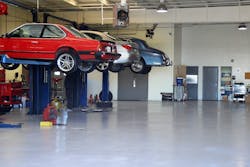A Formula for Maximizing Efficiency in Each Bay
When pointing out examples of what a shop is truly capable of, consultant John Wafler points to Auto Care Plus, a four-bay, two-technician shop in Merrimack, N.H., that produces $1.5 million in revenue each year.
The shop's secret?
The owner of the shop, John Manelas, is all about getting the most production and efficiency out of each one of his bays, Wafler, a facilitator with RLO Training’s Bottom-Line Impact Groups (BLIG), says.
Wafler’s system, which he uses through BLIG, looks at the bay-to-technician ratio of a shop and how that can be used to find its maximum production and efficiency.
John Manelas has worked with Wafler and used a variation of this system to reach an average of $45,000 in sales per bay throughout his six shops. Manelas’ Merrimack shop produces $55,000 per bay, the highest Wafler has seen.
Auto Care Plus’ monthly average per bay is much higher than the benchmark of BLIG, which requires producing over $25,000 in sales (parts and labor) per bay per month. Wafler and Manelas give insight into the strategies and how to maximize the use of each bay in your shop.
Before You Start: Understand What to Track
—
Wafler describes the standard guidelines for a shop using this system, which can apply to a shop of any size. For maximum efficiency, your goal should be 1.5 bays per technician, and you need to make sure cars don’t sit on lifts any longer than they have to. He says a shop could go as low as one bay per tech, but that can be hard to pull off depending on your technician’s skill set.
Then, a shop should have one service advisor per 1.5 to 2 technicians to make sure the work can be sold effectively, and customers looked after at a high level.
“Depending on the skill levels of the technicians and service advisors, a six-bay shop with four or 4.5 techs and 2.5–3 advisors (which can include two service advisors and a trainee or customer service representative) should be able to produce $135,000–$150,000 per month, or $1.6 million–$1.8 million per year,” Wafler says.
To track this, there are two measurements for technicians—productivity and efficiency. Wafler says it’s important to properly measure and differentiate the two.
Productivity measures how many hours per day technicians work on cars versus standing around, or waiting for parts. Efficiency simply measures how quickly a technician gets the job done when they’re working on cars.
Wafler’s goal is to get clients to a 90 percent or higher productivity rate, which means technicians should be working about 7.2 hours in an eight-hour day. Efficiency numbers should hover around 125 percent, which means a technician working on cars for 7.2 hours in a day should produce 9 billable hours of work.
So, if you have four technicians covering six bays, and two service advisors for those technicians, and everyone is operating at peak efficiency and productivity, each bay should produce more than $25,000 in parts and labor sales per bay per month.
Manelas has used these benchmarks throughout his shops since 2009, soon after joining Wafler’s group. He knew he wanted to hit Wafler’s benchmarks, but, beyond that, wanted to reach the highest production possible in his shop.
“I look at it as a point of total employees I have and how much revenue I expect,” Manelas says. “I want to be in the $200,000–$250,000 revenue range per employee. Not all of my shops run that efficiently, but that’s what I strive for.”
How to improve your numbers:
1) Keep score.
Manelas compiles all of this information into what he calls “the scorecard,” which is routinely given to each of his employees. These show the KPIs, hours billed, efficiency and productivity of each technician. If they’re not hitting the productivity and efficiency benchmarks decided by this system, Manelas works with his technicians to get to the root of the issue.
“Humans, by nature, like keeping score, and I think this just ups their game,” Manelas says.
“Without measuring productivity and efficiency, you don’t know if it’s a technician problem, service advisor problem, or a process problem,” he adds. “Measuring will point to the right direction for the cure.”
2) Demonstrate time wasted.
Being a part of BLIG means that shop owners need to have a tech time management system. This calculates how many dollars per minute it costs the store to not be turning a wrench per minute, which, at Manelas’ last check, was $3.47.
He’s able to specifically tell his technicians that for every minute they spend doing something non-work related, they’re wasting the shop $3.47.
3) Keep a lean staff.
Manelas says his most productive shops are actually the ones with the fewest staff members, because the limited staff creates a sense of urgency and eliminates complacency.
“It inherently breeds that the front counter has to be on the ball, getting the right parts,” Manelas says. “There’s no room for inefficient stuff.”
When implementing a system like this, Manelas says it’s important to buy into it and work to understand everything, while getting the rest of your staff on board.
“The staff has to understand why it’s important,” Manelas says. “When you can tell your staff why you’re doing something, they’ll appreciate it a lot more.”
4) Identify problems from the top.
It’s very important to measure efficiency and productivity, otherwise you have no idea where you’re at. Wafler says that many shops immediately blame the technicians for any efficiency issues, when they may need to start from the top.
If you have measured your numbers and they’re lower than the benchmarks, Wafler says that you should first look at the processes set in place by yourself and your service advisors. Owners and service advisors play a huge role in all of this, as they oversee the production itself.
“More often than not, we find that the service advisors are not selling properly, or they don’t have a good inspection process in place,” Wafler says. “Once you get that dialed in, it comes down to the technicians and how quickly they can get the job done.”
5) Assign work out effectively.
Service advisors also need to make sure they’re not giving a technician too many hours of work beyond his or her skill set, which can reduce his or her time to get quality work done, according to Wafler.
Manelas agrees with this, and says it’s important to start from the top. When you dig into things, he says, productivity issues are not on the technician, as he or she is often waiting for parts or for vehicles to be assigned.
“The staff has changed over the years, the technicians have changed,” Manelas says. “We proved that it is not necessarily all with the technicians’ talent.”
6) Incentivize your staff.
Giving staff members an incentive to do well is also an important aspect, Manelas says. Even though he gives out scores and report cards, Manelas says he makes sure to celebrate the victories when they happen, and give some positive feedback. Otherwise, he says, it isn’t even fun to win.
“It really comes down to the store management making it a fun environment and celebrating the victories, rather than beating people down and punching time clocks,” Manelas says.

